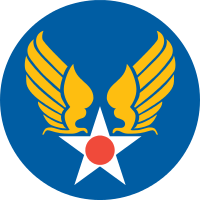North Dakota World War II Army Airfields
North Dakota World War II Army Airfields | |
|---|---|
| Part of World War II | |
 Bismarck MAP Fargo MAP Minot MAP Grand Forks MAP Map Of North Dakota World War II Army Airfields | |
| Type | Army Airfields |
| Site history | |
| Built | 1940-1944 |
| In use | 1940-present |
During World War II, the United States Army Air Forces (USAAF) established numerous airfields in North Dakota for training pilots and aircrews of USAAF fighters and bombers.
Most of these airfields were under the command of Second Air Force or the Army Air Forces Training Command (AAFTC) (A predecessor of the current-day United States Air Force Air Education and Training Command). However the other USAAF support commands (Air Technical Service Command (ATSC); Air Transport Command (ATC) or Troop Carrier Command) commanded a significant number of airfields in a support roles.
It is still possible to find remnants of these wartime airfields. Many were converted into municipal airports, some were returned to agriculture and several were retained as United States Air Force installations and were front-line bases during the Cold War. Hundreds of the temporary buildings that were used survive today, and are being used for other purposes.
Major airfields
Air Transport Command
- Bismarck MAP, Bismarck
- Joint use USAAF/Civil Airport
- Now: Bismarck Municipal Airport (IATA: BIS, ICAO: KBIS, FAA LID: BIS)
- Fargo MAP, Fargo
- Joint use USAAF/Civil Airport
- Now: Hector International Airport (IATA: FAR, ICAO: KFAR, FAA LID: FAR)
- And:
 Fargo Air National Guard Base
Fargo Air National Guard Base
- Port O'Minot, Minot, North Dakota
- Joint use US Navy/USAAF/Civil Airport
- Now: Minot International Airport (IATA: MOT, ICAO: KMOT, FAA LID: MOT)
- Note: Minot Air Force Base (1957-Present) is NOT this facility.
Army Air Force Training Command
- Joint use USAAF/Civil Airport
- Contract Pilot School
- Non aviation use, redeveloped and part of urban area of Grand Forks.
- Note: Grand Forks Air Force Base (1957-Present) is NOT this facility.
References
- Maurer, Maurer (1983). Air Force Combat Units Of World War II. Maxwell AFB, Alabama: Office of Air Force History. ISBN 0-89201-092-4.
- Ravenstein, Charles A. (1984). Air Force Combat Wings Lineage and Honors Histories 1947-1977. Maxwell AFB, Alabama: Office of Air Force History. ISBN 0-912799-12-9.
- Thole, Lou (1999), Forgotten Fields of America : World War II Bases and Training, Then and Now - Vol. 2. Pictorial Histories Pub . ISBN 1-57510-051-7
- Military Airfields in World War II - North Dakota

